Got little bugs buzzing around your kitchen? Congrats, you may have fruit flies! Don’t fret – these annoying pests are pretty common. And luckily, it doesn’t take a lot of money, supplies, or effort to get rid of them. In fact, you can probably find everything you need in your cabinets! We recently tested 7 different methods to get rid of them, so here are the best fruit fly traps and how to make them.
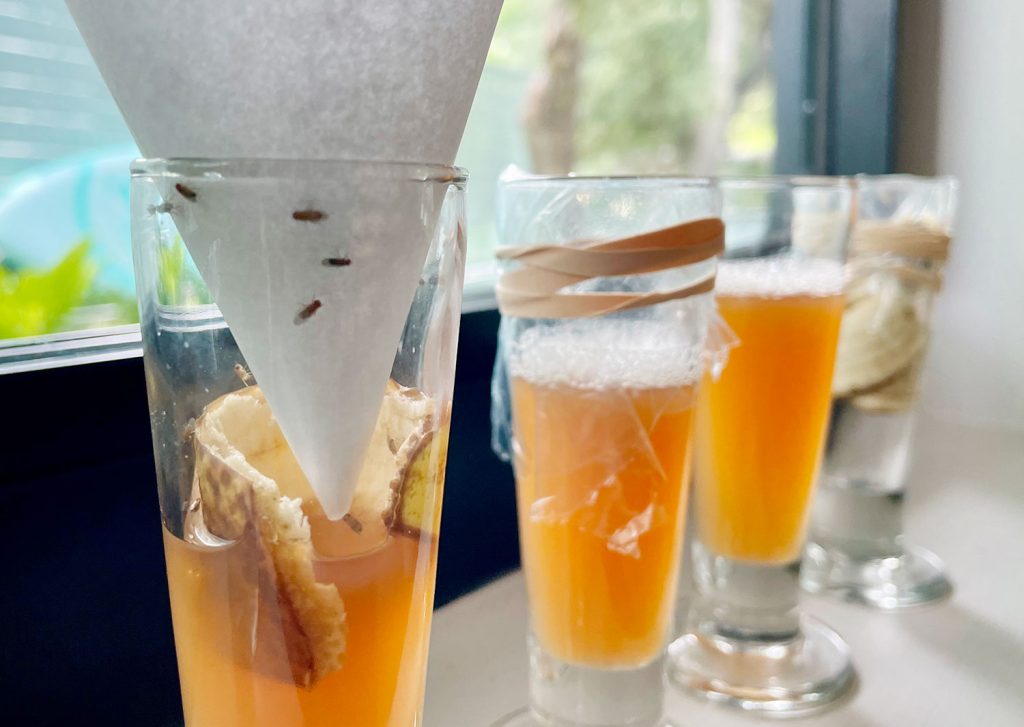
Each homemade trap is easy to make and uses natural ingredients that we already had around the house. So let’s just call this extremely D.I.Y friendly and chemical free. We’ll also share some tips for preventing a fruit fly infestation in the first place.
What Are Fruit Flies?
Fruit flies are small flying pests that are attracted to sweet fruits and some vegetables. They’re also drawn to sugary or fermented beverages like beer, wine, or juice. You may spot them swarming around fruit bowls, garbage cans, and even kitchen drains. They’re about the size of a grain of rice and look like small, tan houseflies with red eyes. They tend to show up in the summer or late fall when many fruits are in season.
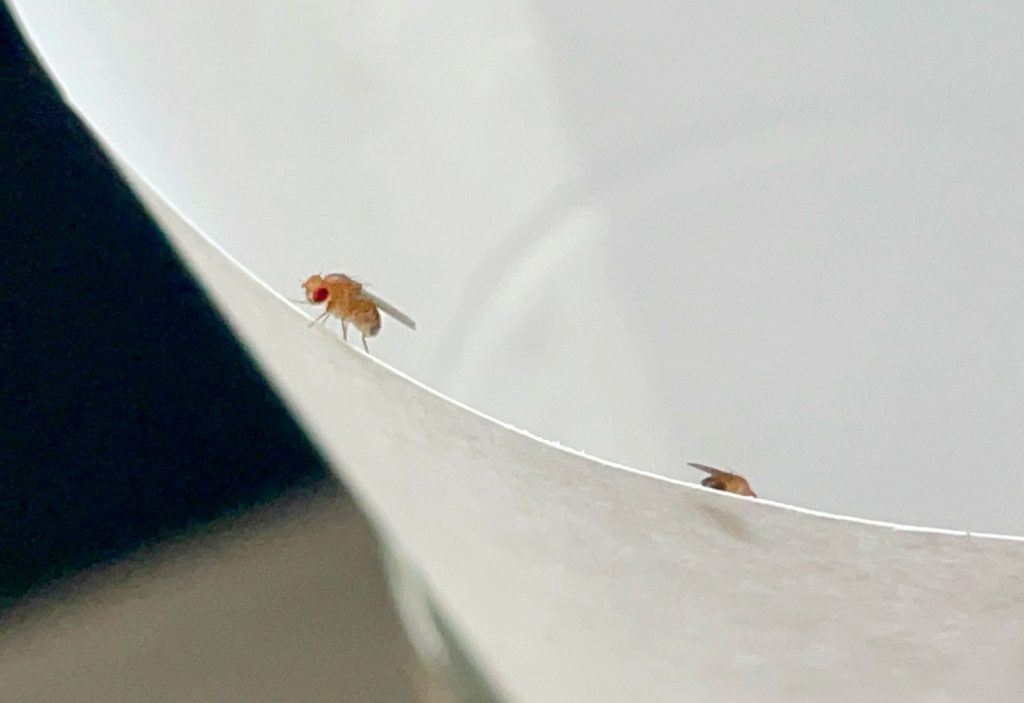
Problems usually begin when fruit flies hitch a ride home on a piece of storebought fruit. Females can lay hundreds of eggs in their short lives, each hatching within as little as 12 hours. Since they reach adulthood in just a few days, a few pests can quickly turn into a swarm. That’s why it’s important to get rid of fruit flies as quickly as possible.
Fruit Flies Vs. Fungus Gnats Vs. Drain Flies
Fruit flies are easily confused with other common household pests, especially fungus gnats and drain flies. Correctly identifying your bugs will ensure you pick the right way to get rid of them. The easiest way to distinguish them is by where you spot them and what larger insect they resemble.
- Fruit flies look like small flies. They’re found near fruit bowls, trash, or other smelly food sources.
- Drain flies look like small fuzzy moths. They’re typically found near sinks and drains.
- Fungus gnats look like small mosquitos. They’re typically found near houseplants, since they breed in damp soil.
If you’re unsure, you can try one of the traps below and if it attracts the pests in your home, you’ve got fruit flies!
4 DIY Fruit Fly Traps
Getting rid of fruit flies isn’t complicated or expensive. All you need are some household supplies and a little bit of patience. Each trap follows the same basic formula: attract the fruit fly + keep it from escaping. We tried the following 4 DIY methods and definitely had a clear winner in the end:
- Funnel Trap
- Plastic Wrap Trap
- Dish Soap Trap
- Rotting Fruit Trap
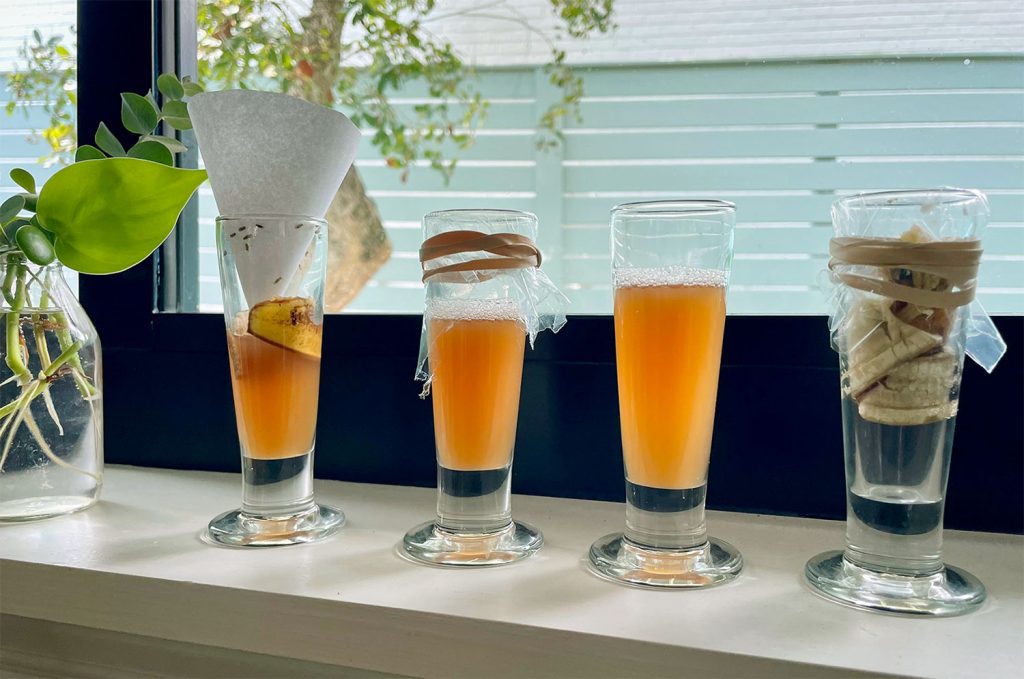
I’ll share more details about each method below, along with our verdict at the bottom. Some traps work faster than others, and all may take several days to fully eradicate your issue.
#1: Funnel Fruit Fly Trap
This trap attracts fruit flies in a container through a homemade paper funnel. The flies find their way in but have difficulty getting back out through the small hole in the bottom.
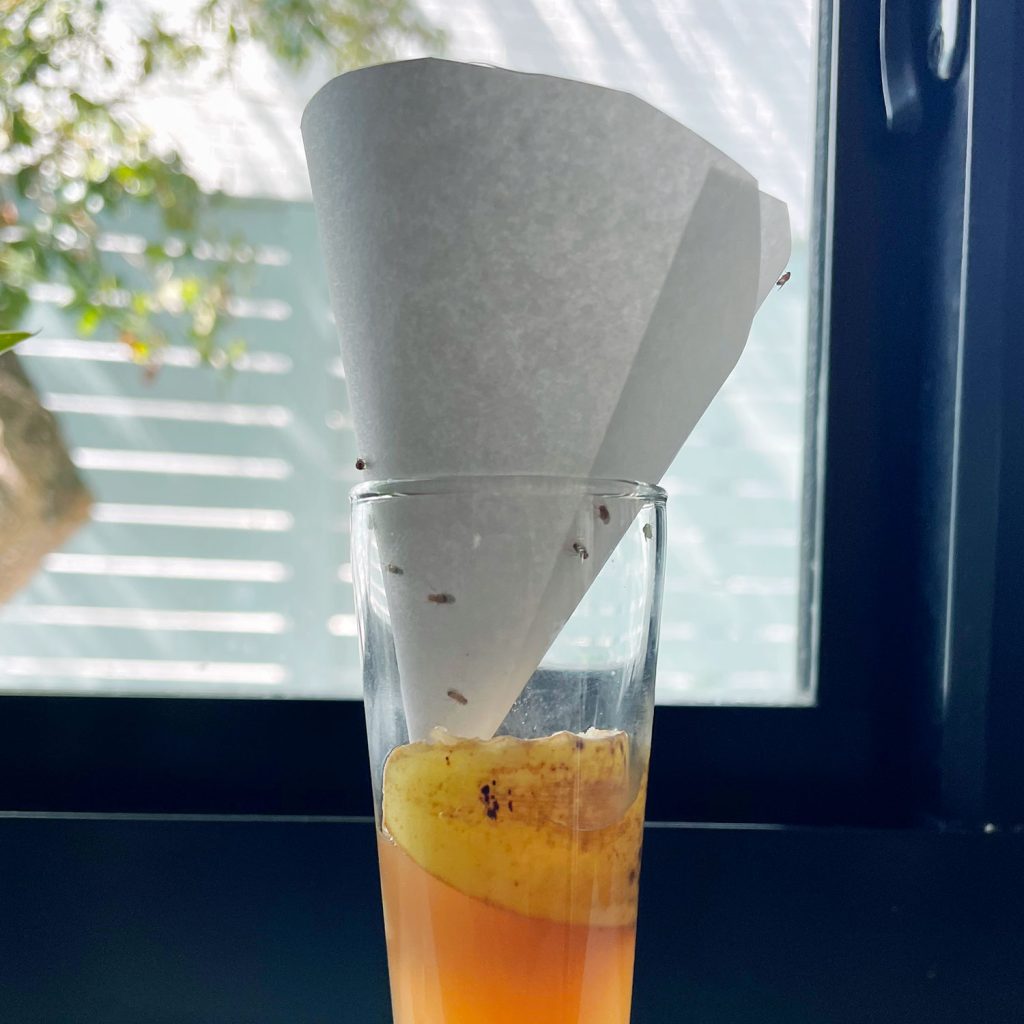
Materials needed:
- Small, clear container with a narrow opening
- Piece of paper or cardstock
- Tape
- Scissors
- Apple cider vinegar (ACV)
Instructions
- Select your container. Find a small, clear container like an old food jar or plastic soda bottle. It’s best if it has a small or narrow opening.
- Add apple cider vinegar. Pour apple cider vinegar, old beer, or wine into the bottom of the container. The scent will attract the flies. Old beer or wine also works too, but not regular white vinegar.
- Make a paper cone. Wrap a small piece of paper or cardstock into a cone shape. Secure the shape with tape. Leave or cut a very small opening at the end – about the size of a grain of rice.
- Place the funnel. Set your paper funnel onto the opening of your container. Make sure it fully covers the opening without touching the ACV. Reshape your funnel if needed.
- Wait & release outside. After you’ve trapped several flies, carefully bring the trap outside, remove the funnel, and let them fly away. Be careful not to shift or knock over the funnel inside before you’re ready to release the flies.
You can also try this method with a storebought funnel, however you may find that the opening at the bottom of storebought funnels is too large and lets too many fruit flies out of your trap.
#2: Plastic Wrap Fruit Fly Trap
This trap works by attracting fruit flies into a container through small holes in the plastic-wrapped top. Like the trap above, they have trouble finding their way back out.
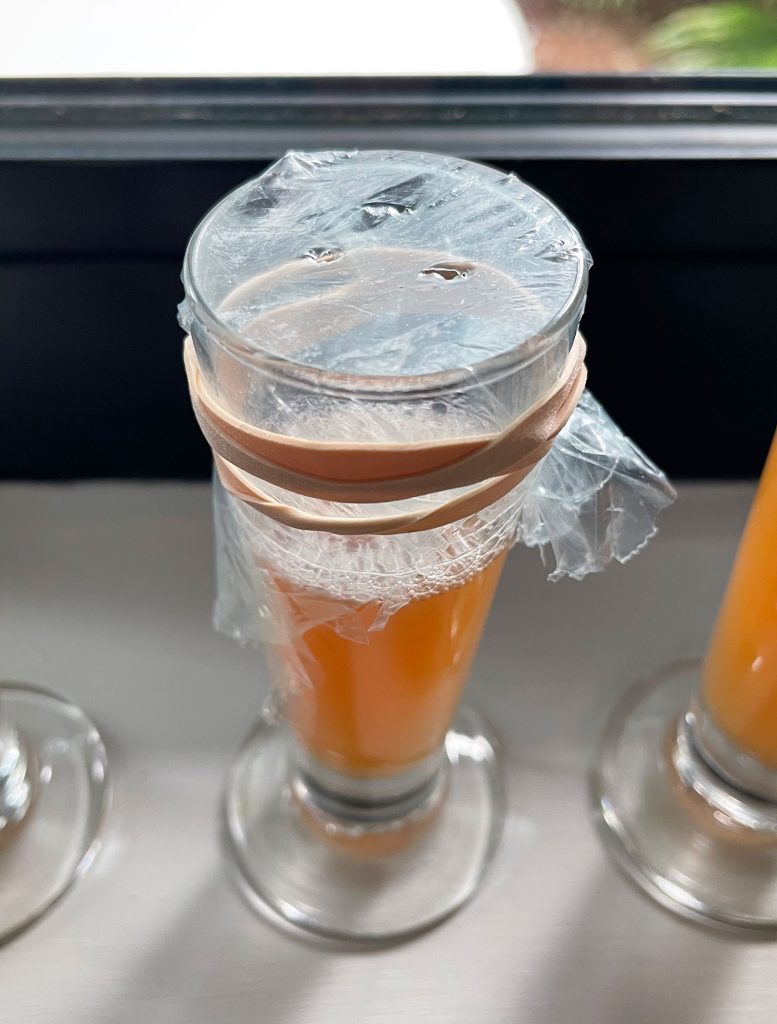
Materials needed:
- Small clear jar, cup, or container
- Rubber band
- Plastic wrap or plastic bag
- Toothpick
- Apple cider vinegar (ACV)
Instructions
- Choose your container. Find a small clear, jar, cup, or other glass container. Using something clear makes it easier to see the flies your trapping, but an old soda or beer can works too.
- Add apple cider vinegar. Pour apple cider vinegar (old beer or wine also works) into your container. The smell will attract fruit flies.
- Cover with plastic wrap. Wrap the opening tightly with plastic wrap and secure it with a rubber band.
- Poke small holes. Use a toothpick to poke a few small holes in the top of the plastic. You don’t need a lot. Just make sure they are big enough for a fly to fit through.
- Wait and release. After a few days, bring the trap outside carefully and remove the plastic wrap to release them.
This technique can also be done by poking a hole in the lid of a metal jar lid. You can use a mason jar or old food jar for this. Use a hammer and nail to puncture the top.
#3: Dish Soap Fruit Fly Trap
Unlike the previous two methods, this fruit fly trap doesn’t require making any covers. Instead, it relies on a soapy surface to keep these pets from flying away. Note: this one doesn’t allow you to set them free outside, as they get coated in the soap.
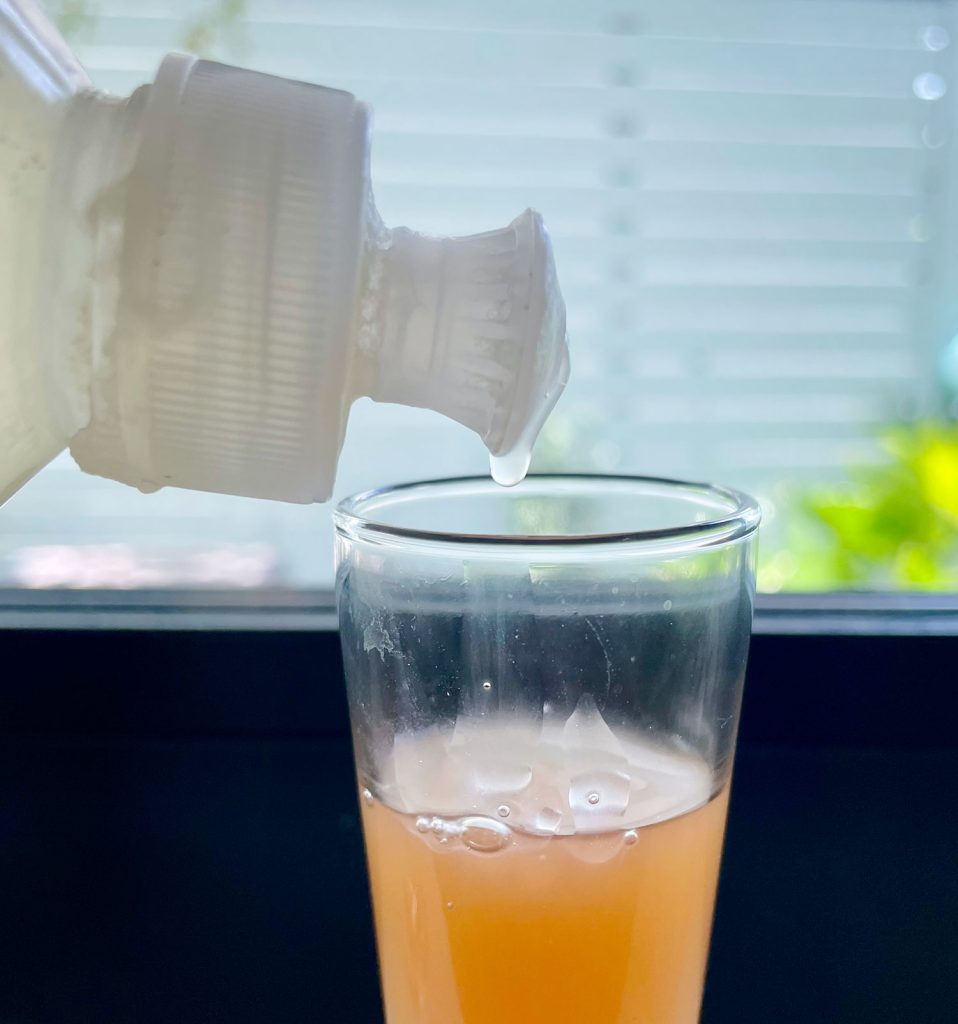
Instructions
- Gather your materials: You’ll need a small glass container, bowl, or shallow dish, as well as some apple cider vinegar (ACV) and dish soap.
- Put apple cider vinegar in glass or shallow dish. Fill the bottom of a small container, bowl, or dish with apple cider vinegar. This scent will attract the fruit flies.
- Add dish soap & mix. Squirt several drops of dish soap into the ACV and mix to create a soapy solution. Flies will land on the mixture but then find it difficult to fly away.
This technique can also be combined with the plastic wrap and funnel method. Just add some dish soap to the apple cider vinegar before you cover the top.
#4: Rotting Fruit Trap
Fruit flies love rotting fruit, so we also tested out some traps where used actual fruit instead of apple cider vinegar as our lure.
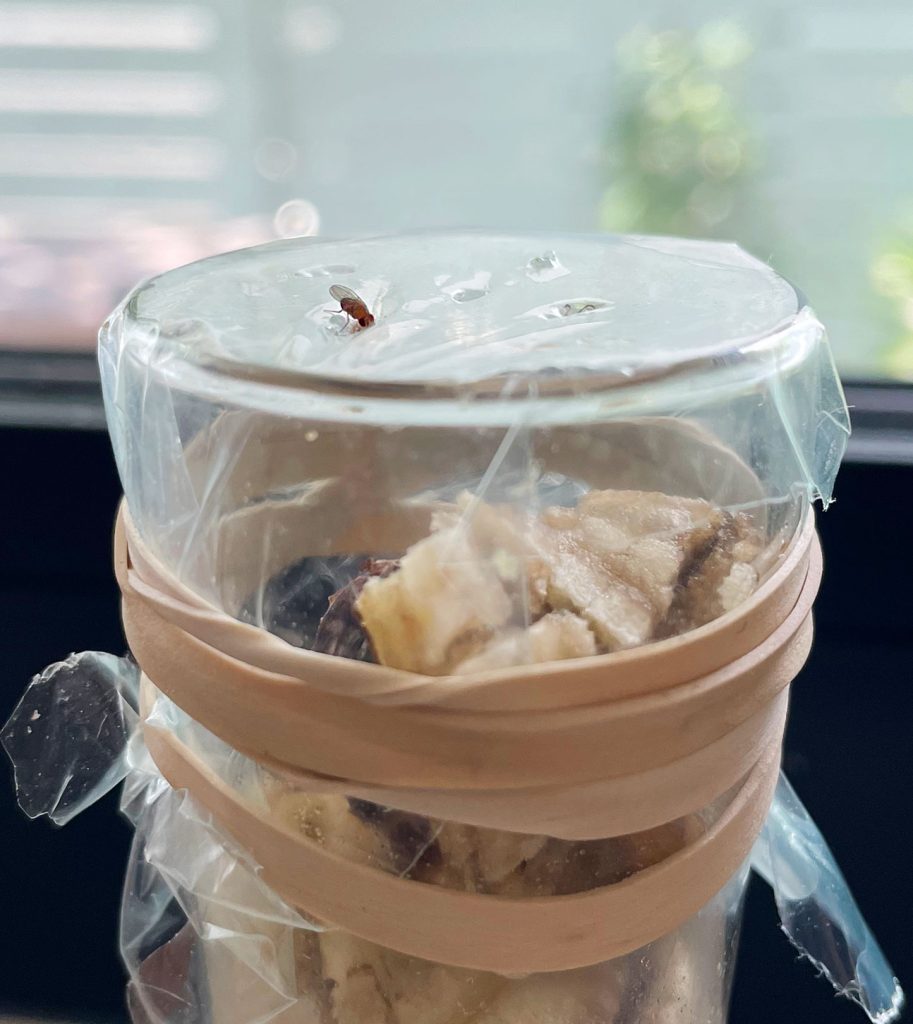
Materials needed:
- Small glass jar, cup, or container
- Plastic wrap or paper funnel, depending on your chosen trap mechanism
- A small fruit scrap, like a banana peel or strawberry slice
Instructions
To create a rotting fruit trap, substitute apple cider vinegar for a piece of banana peel, apple slice, or peach in either the Plastic Wrap Trap or Funnel Trap. You can also add this fruit scrap into ACV as well. Just be prepared to swap out your fruit scrap every day or two so you don’t introduce unwanted smells to your kitchen.
The Best Fruit Fly Trap
We set out these 4 different versions of these DIY traps to see which performed the best. They were:
- Plastic Wrap Trap (with banana peel)
- Funnel Trap (with ACV + banana peel)
- Plastic Wrap Trap (with ACV + soap)
- Dish Soap Trap (with ACV)
For us, the best traps were less about what type of trap we used and more about the lure. Anything with banana peel performed MUCH better than apple cider vinegar.
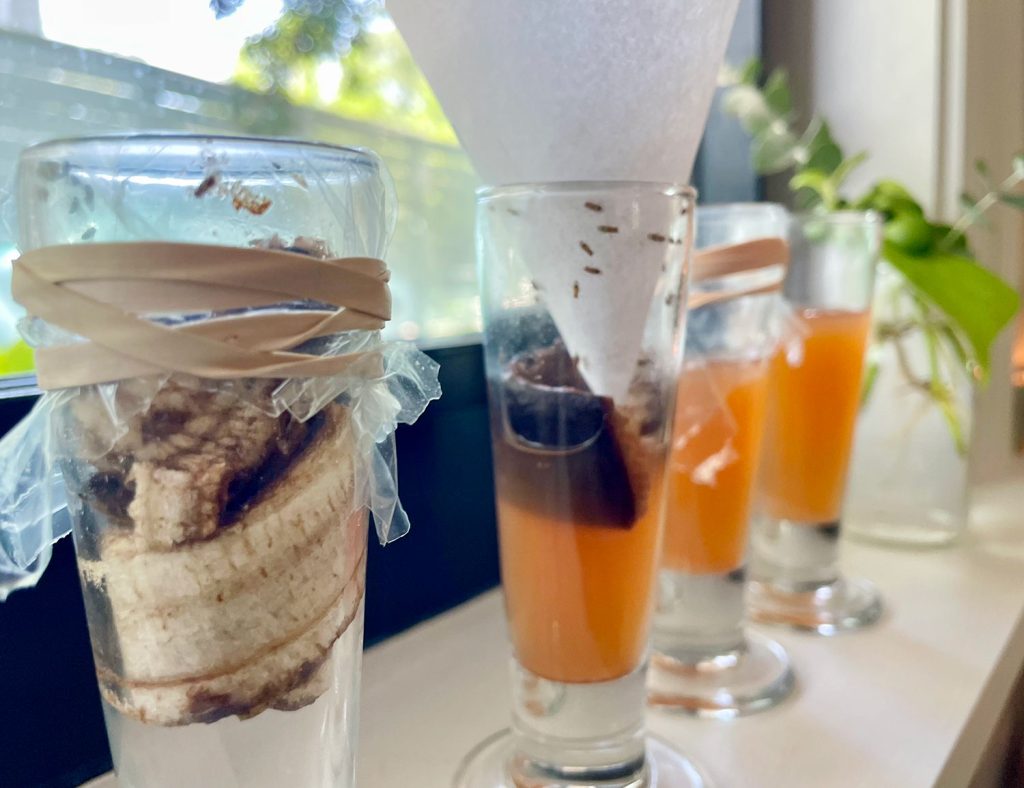
Our two Plastic Wrap Traps were nearly identical, but the one with the banana peel dramatically outperformed the one with the ACV + soap. Maybe ACV is less enticing when there’s real fruit nearby?
So no matter what trap you set up – add a fruit scrap to it! We had a slight preference for the plastic wrap trap because it was easier to make and less prone to disruption. I accidentally knocked over our funnel once and released half of the flies back into the kitchen. Oops!
What Attracts Fruit Flies Best?
Since we had such good luck using fruit scraps, we also wanted to test which kind of fruit was the best bait. We used three fruits we already had on hand: a banana peel, apple slices, and a strawberry. We put each in a Plastic Wrap Trap side-by-side on our countertop for 24 hours.
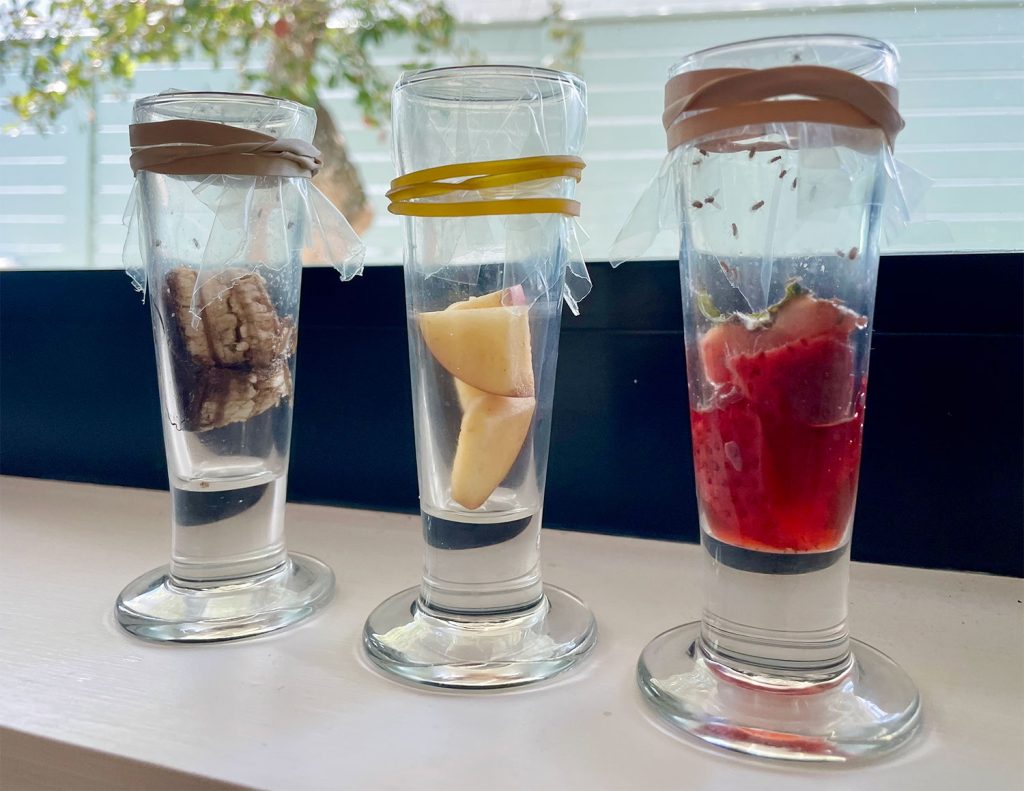
Although the banana peel started off strong (it was the most rotten at the beginning), the fruit flies ended up being the most attracted to the strawberry. The banana peel still snagged several flies, but the longer the strawberry rotted, the more flies it caught. The apple slices didn’t catch a single one!
Storebought Fruit Fly Traps
If you’re not having any luck with these DIY solutions or don’t have the time or materials to make them, there are premade traps you can buy instead. All have thousands of positive reviews and cost less than $20. They might be worth considering if you want something that catches other types of flying insects, or if you want something more discreet than than a DIY trap.
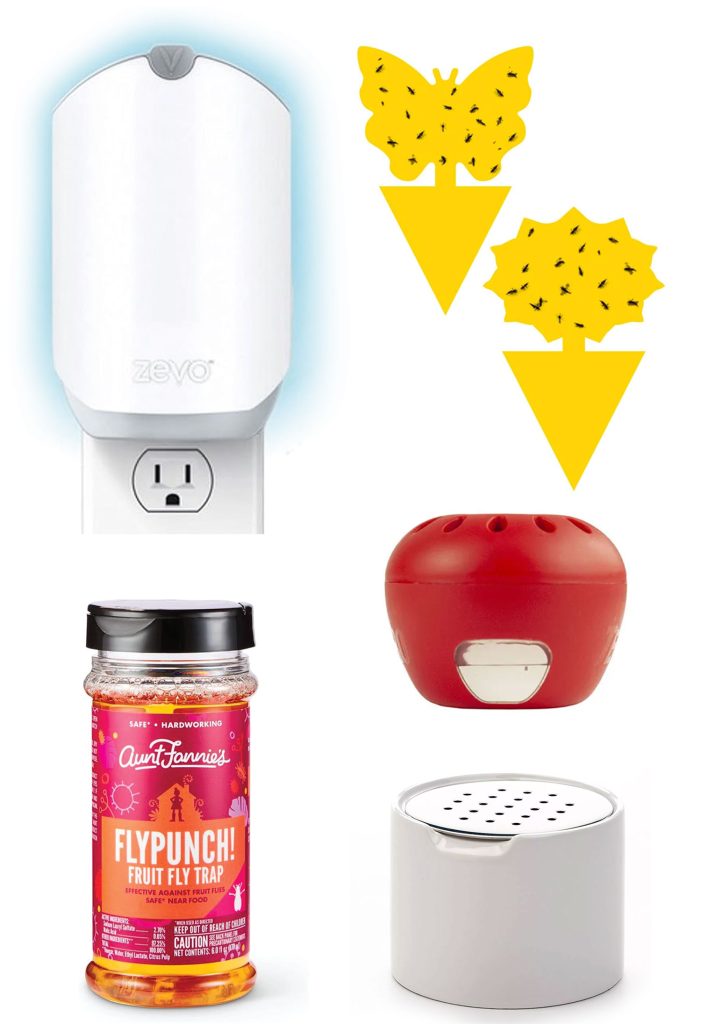
- Zevo Flying Insect Trap ($19): This trap plugs into an outlet and uses UV light to capture fruit flies, fungus gnats, houseflies, and more.
- Landisun Sticky Traps ($12): These small sticky traps can be staked close to the source of the problem, whether they’re fruit flies on your countertop, mosquitos outside, or fungus gnats near your plants.
- Terro Fruit Fly Traps ($15): Apple-shaped traps that lure fruit flies in with liquid bait and prevent them from escaping. This works only for fruit flies.
- Aunt Fannie’s FlyPunch ($8): This plant-based liquid bait trap looks like a stylish spice jar filled with a pungent punch that fruit flies are drawn to.
- Sur La Table Fly Trap ($15): This stylish trap disguises its less-than-pretty function, but doesn’t come with any lure (you need to add your own ACV or fruit).
During our little experiment, I picked up a pack of Terro Traps to see if they performed better than my homemade methods. I left one out for 24 hours next to our banana & strawberry traps to see which of the three performed best.
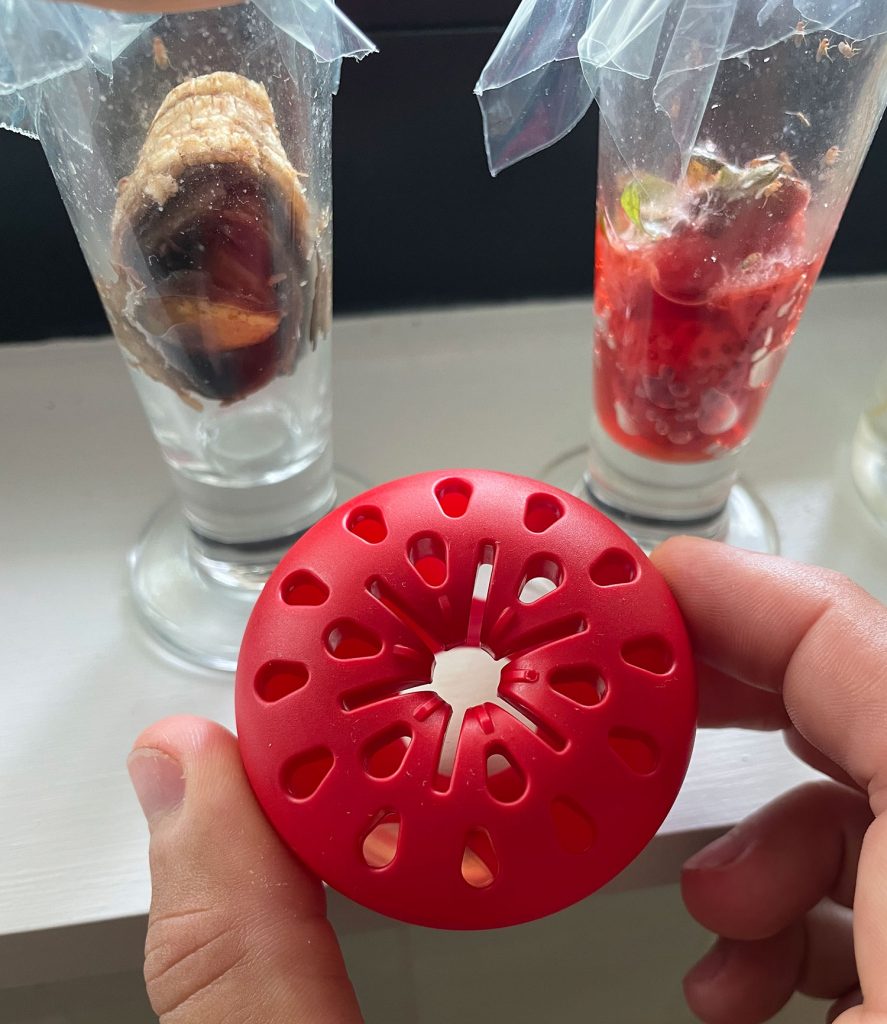
Once again, our homemade strawberry trap did best, followed closely by the homemade banana peel trap. The storebought trap caught only one. HOWEVER…
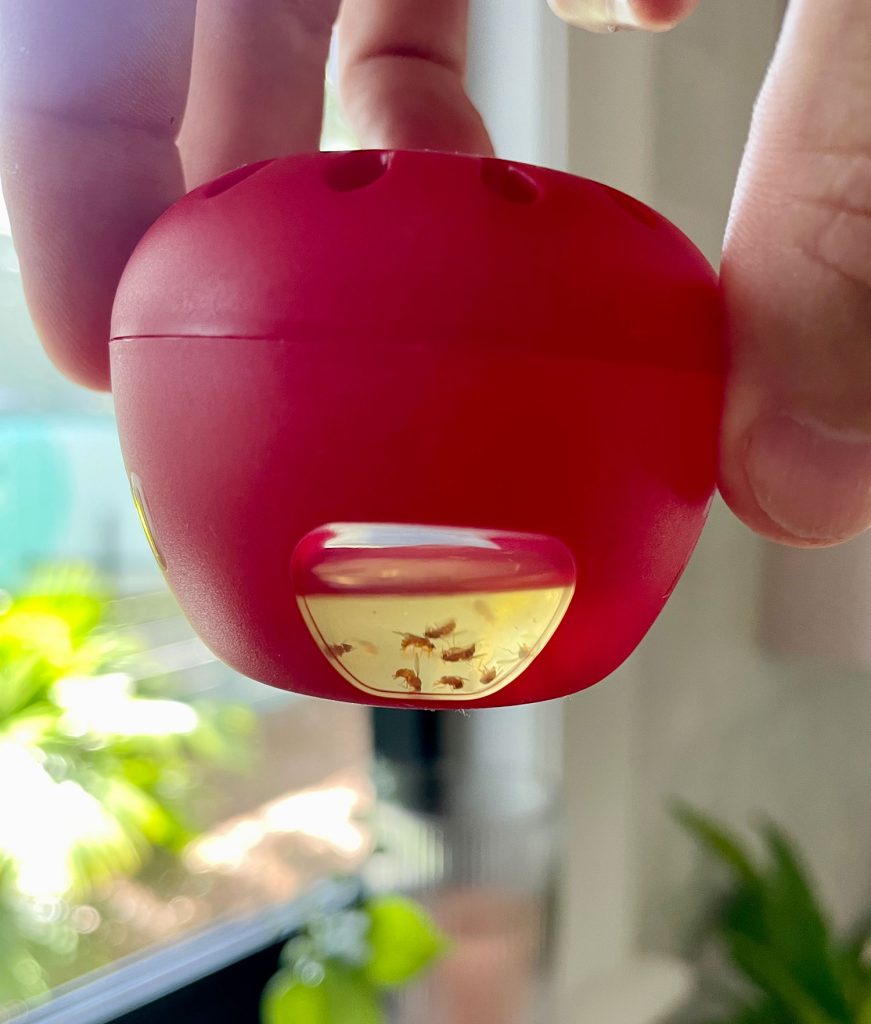
We then discarded both of our DIY traps and left out the storebought trap for another 24 hours. That’s when it caught the collection you see above. So storebought traps definitely work, just not as well or as fast as our homemade traps did.
Our verdict? Use storebought traps if you want something more discreet looking, especially if you plan to leave it out indefinitely… but there is nothing bad about the homemade ones, in fact we found them to be the best way to get the fruit flies right away!
How To Prevent Fruit Flies
Getting rid of fruit flies is pretty simple, but the best-case scenario is to stop them from invading in the first place. Here are some simple ways you can prevent fruit flies from taking up residence in your home.
- Clean kitchen surfaces. Wipe down kitchen counters, stovetops, tables, and any other surfaces that may collect food residue or spilled liquids. Fruit flies are especially attracted to fruit, sweet juices, and alcohol so don’t let those sit!
- Take out your trash. Leaving food scraps in your garbage overnight can quickly turn your trash can into a fruit fly breeding ground.
- Dispose of overripe fruit. Monitor your fruit bowl for browning or rotting apples, bananas, etc so you can get rid of them before they become a problem.
- Wash your fruit as soon as you get it home. You can eliminate eggs or larvae that might come home from the store by washing produce right away (except for berries, which could rot faster from the moisture).
- Store produce in the fridge when possible. Fruit flies won’t flourish in the cold, so when in doubt, try storing your fruit and vegetables in the refrigerator.
- Clean your sink drain. Food scraps left in your drain can also attract fruit flies, so make sure you run your garbage disposal and/or flush the drain regularly.
Lastly, don’t panic when you spot fruit flies in your home. Yes, you want to take action quickly to prevent the problem from getting worse. But the solutions in this post are easy, effective, and fast-acting. You might even have some fun becoming a fruit fly scientist like I did.
*This post contains affiliate links, so we may earn a small commission when you make a purchase through links on our site at no additional cost to you.
